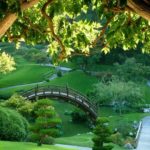Nothing in a Japanese Garden is left to nature or chance. Every piece is carefully selected and placed in a specific way to create a series of vignettes or moments of interest throughout the garden.
The Japanese garden is a miniature representation of a picturesque world. Techniques used vary and designers often play with proportion to create the illusion of depth, and utilize smaller scale items such as rocks and water features as symbols of land and sea. Items outside the garden such as temples or rolling hills are incorporated into the landscape to make the spaces seem much more expansive. Balance is also incredibly important, but not necessarily symmetry. The spaces and pathways are meant to be soothing and welcoming to its visitors; but also provoke moments of curiosity by concealing elements from certain angles, encouraging further exploration.
Some traditional elements found in a traditional Japanese Garden: Rocks, Sand, Bridges, Stone Lanterns, Water Basins, Fences, Gates, Trees, Flowers
You are reading

